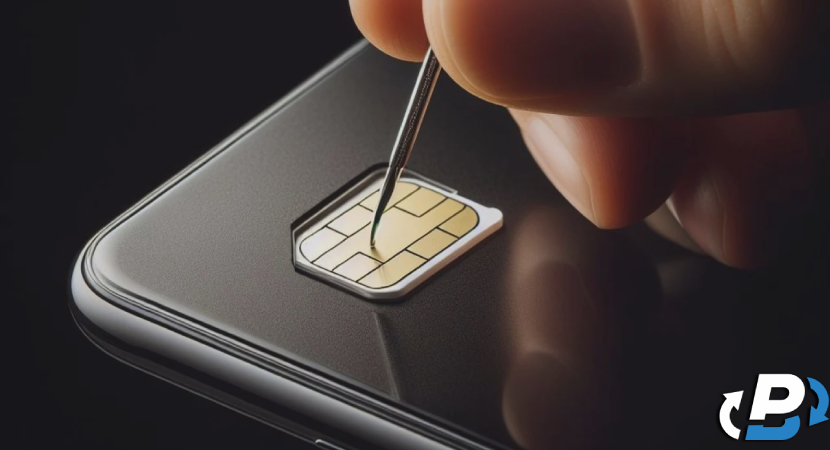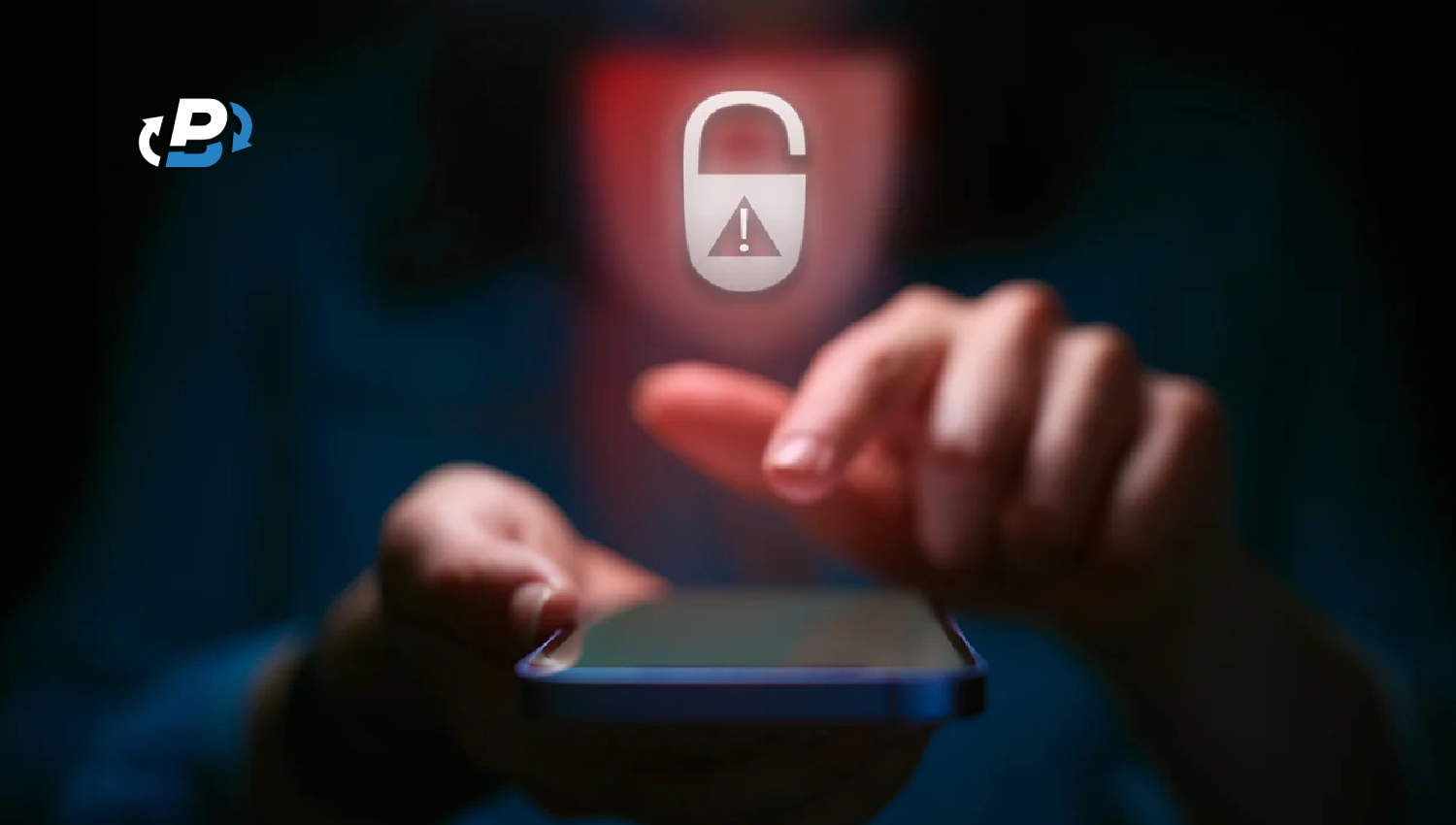Yes, you can protect your crypto wallet from SIM swapping by using authenticator apps like Google Authenticator instead of SMS codes as an extra layer of protection. This way, even if scammers swap your SIM card and gain access to your messages, they still won’t be able to access your wallet. As you'll know by now, security is a big deal to us at PlasBit, and it should be to you too! Follow the advice in this article to stay as safe as possible online and enjoy your crypto experience.
How a SIM Swap Scam Happens on Your Crypto Wallet
A SIM swap scam, also called SIM swap theft or SIM hijacking, is when someone takes your phone number by tricking your carrier into moving it to a different SIM card. The scammer can then take over your calls, texts, and, most importantly, any SMS-based two-factor authentication (2FA) codes you use to log in to your online and banking accounts.
How Thieves Carry Out a SIM Swap Attack
Finding out personal details - Phishing emails, fake websites, or social media accounts are the first places thieves get your personal information, like your phone number, social security number, and account information. Also, they might try to trick you or customer service reps into giving them personal information by using social engineering.
Talking to your cell phone provider - Once the scammer has enough personal information, they call your cell phone company pretending to be you. They say they lost their phone or SIM card and need to move the number to a new SIM card. They could answer security questions with information they already have, which would trick the carrier into letting them make the move.
Moving a SIM card- Your phone number is moved to the scammer's new SIM card once the carrier agrees to the request. You can't make calls or send texts after this because your original SIM card is turned off.
Using One-Time Codes and SMS Authentication to Hack - The hacker now has all of your SMS-based one-time passwords and verification codes because they have your phone number. Then, they can change your passwords and get into your online accounts, like your bank accounts, social media accounts, and cryptocurrency wallets without your permission. They can drain bank accounts and steal cryptocurrency once they get in.
Protect Against SIM Swap Fraud
To stop people from swapping SIM cards, you need to make your protection stronger. Biometrics (fingerprint or face recognition) or multi-factor login apps like Google Authenticator should be used instead of SMS-based authentication. Also, call your cell phone company and ask them to add a PIN or some other extra protection to your account. This can make it harder for thieves to pretend to be you and start a SIM-swap attack. You can keep your phone number, personal information, and cryptocurrency safer from being stolen if you know how a SIM swap attack works. Knowledge is power in crypto, just as in any other walk of life, so by taking these steps, you can help keep your phone and bank accounts safe from thieves who want to take advantage of weak spots. Can you protect your crypto wallet from sim swapping? You bet.
The Rising Popularity and Impact of SIM Swap Attacks on the Crypto Sector
Because hackers can make so much money with SIM swap attacks, they have become very popular in the crypto world. Since the value of cryptocurrencies like Bitcoin and Ethereum keeps going up, scammers are targeting crypto holders more and more through SIM swap scams. But why do SIM swap attacks happen more often now? There are many reasons why SIM swap attacks have become more widespread. This is because hackers like the fact that cryptocurrency is decentralized, which means that stolen funds are hard to get back once they are moved to another bank. In traditional banking, charges can be reversed or refunded. Because cryptocurrency transactions are anonymous and final, crypto users are at risk once a SIM swap attack succeeds. Second, cell carriers are still vulnerable to hacking, even though people are becoming more aware of SIM swap fraud. Criminals often take advantage of how carriers handle customer service by pretending to be the account owner and getting the provider to let them move the number to a new SIM card. Scammers are getting smarter, which makes it easier for SIM swap attacks to happen even though security measures are in place. As the cryptocurrency market grows, SIM swap scams are getting bigger and more dangerous.
Several well-known people in the crypto world were attacked in 2021 and lost large amounts of Bitcoin, Ethereum, and other decentralized currencies. The damage these attacks cause to people's finances is often permanent and can leave them with few or no options to recover. So what the crypto industry is doing about it? As the risk of SIM swap fraud grows, many crypto platforms and wallet providers are telling users to stop using SMS-based authentication and switch to two-factor authentication (2FA) or hardware authentication instead. Some exchanges are also making accounts safer by adding multi-factor authentication (MFA), which needs biometric data or login apps. People who own cryptocurrencies are also told to make their phones safer by setting strong account PINs, checking their phones often for signs of SIM swaps, and storing their digital assets in advanced security methods like encryption and cold wallets. To fight this growing threat, crypto users need to protect their phone numbers, make their accounts safer, and stay away from SMS-based two-factor authentication. There's a mine of information on the PlasBit website for newbies and experienced crypto investors alike that can help keep you safe.
Steps to Detect If Your Mobile Phone's SIM Card Has Been Swapped
It's really important to recognize a SIM swap attack as soon as possible to keep your personal and bank accounts as safe as possible. People who switch SIM cards often don't realize it until it's too late, but there are a few things you can do to tell if your card has been hacked.
1. Loss of cell phone service all of a sudden
If you suddenly lose service on your cell phone, this is often a sign of a SIM swap attack. If all of a sudden your phone stops taking calls or text messages and shows "No Service" or "Emergency Calls Only," this could mean that someone has moved your phone number to a new SIM card.
2. Problems getting calls or text messages
Someone may have taken over your phone number if you stop getting text messages with one-time passwords or proof codes for two-factor authentication (2FA). If SMS-based authentication stops working or you have trouble getting calls, you should be worried about SIM swap fraud.
3. Failures of Two-Factor Authentication
If you use two-factor authentication (most often via SMS) and try to log in but fail or can't get your authentication codes, it could mean that someone is receiving them through a new SIM card.
4. Getting calls or emails out of the blue
During a SIM swap attack, your online accounts may show strange behavior. You might get calls, emails, or notifications about efforts to reset your password, new login locations, or changes to your account that you didn't expect. It's a clear sign of possible SIM swap fraud if you get alerts that your account is being viewed from devices you don't know.
5. Notifications from your cell phone company
Most of the time, carriers let you know when big changes happen, like when you need to update your SIM card. If you get a message about a SIM card change that you didn't make, call your cell phone provider right away to stop the scammer from getting more access.
6. Not being able to get into online accounts
If you suddenly can't get into your accounts even though you entered the right login information, it could mean that someone has hacked your phone number and changed your passwords, giving them access without your permission. This is especially important for people who own cryptocurrencies since this access could cause them to lose their digital assets.

What to Do If Your Personal Information Falls Victim to a Fraudster Attack
So, can you protect your crypto wallet from sim swapping if your personal information falls into the wrong hands? Well yes; you can protect your personal and financial data by acting immediately if you suspect a SIM switch attack on your SIM card. You should take these precautions if a hacker or scammer steals your phone number:
1. Call Your Mobile Carrier Immediately
Contact your mobile carrier to report a SIM switch attack. Report the issue and ask them to disable your new SIM card. Most carriers have SIM-swap fraud security systems and can help you restore your phone number. Request that they reinstate your SIM card and apply a PIN or password to your account.
2. Change Account Passwords
After regaining control of your phone number, reset the passwords for all your internet accounts, notably email, banking, and cryptocurrency accounts. This keeps hackers from accessing your accounts with information gathered during the attack. Strong, unique passwords should include uppercase, lowercase, numerals, and special characters.
3. Inform Financial Institutions
Inform your bank or financial institutions about the violation. If necessary, request a transaction freeze and regularly monitor your accounts for suspicious activity. If you have cryptocurrencies, hackers may try to access your wallets or exchanges.
4. Check Email and Social Media
Social media accounts are routinely targeted by SIM swap attacks. These accounts allow hackers to mimic you and steal personal data. Upgrade your social media security by changing passwords and enabling features. Attackers may have tried to reset passwords for numerous accounts, so check your email for strange activity.
5. Report the Crime to Police
Consider reporting the attack to law enforcement or a fraud reporting bureau, depending on the severity and quantity of personal or financial loss. This can help investigate the incident and recover cryptocurrency assets, especially in high-value cases.
Factors That Increase the Risk of a SIM Swap Scam for Crypto Users
Listed below are the main factors that put cryptocurrency holders at higher risk of a SIM swap attack:
1. Reusing or Weak Passwords
Using weak passwords or, worse, using the same password for several different online accounts makes it much more likely that you will become a victim of SIM switch fraud. These weak passwords make it easy for fraudsters to access bank and mobile accounts. They also often gain personal information through phishing and data breaches. To lessen their vulnerability to these assaults, as a cryptocurrency user you must make sure your passwords are strong and distinctive. For those asking can you protect your crypto wallet from sim swapping, this is one of the most simple steps to take. And it's entirely free.
2. Using Two-Factor Authentication via SMS (2FA)
For account security, many digital currency owners employ SMS-based two-factor verification; however, this is easily intercepted in a SIM swap attack. If a hacker manages to get your phone number, they can use it to retrieve SMS 2FA codes and access your online accounts without authorization, which includes your cryptocurrency wallet or exchange. Making the switch to hardware- or app-based 2FA greatly lowers this danger.
3. Absence of Security Measures for Cell Phones
It is easier for fraudsters to mimic you and start a SIM switch if you do not enable extra security features with your mobile carrier, including a PIN code. Without further security measures, a hacker can persuade the carrier to move your phone number to a new SIM card with just a few bits of personal information—often obtained through phishing or social engineering.
4. Insecure Accounts on Social Media
To carry out SIM swap fraud, hackers frequently obtain personal information from unprotected social media accounts. For instance, using information that is readily available to the public, they might pose as you or respond to security queries about your phone number, email address, or date of birth. Users of cryptocurrencies should be cautious about sharing too much personal information online and make sure that multifactor authentication and strong passwords are in place to secure their social media accounts.
5. Frequently Using Unsecured Networks and Public Wi-Fi
The likelihood of hackers intercepting your data increases when you use unprotected networks or public Wi-Fi. Users of cryptocurrencies who oversee wallets or exchange accounts while connected to these networks are especially at risk since hackers can use this access to obtain data necessary for a SIM swap attack.
The Role of Social Media in SIM Swap Attacks Targeting Phone Numbers
As we've touched on, the use of social media proves crucial for helping facilitate SIM swap attacks. Accounts are used by hackers to obtain personal data, including date of birth, phone number, email, and even security question answers. To win over service providers, fraudsters often employ social engineering techniques, piecing together fragments of personal information from social media profiles. If your profiles are open to the public then this is a scammer's dream come true. Hackers can gain insight into your life, like details about yourself and your family, including the name of your favorite pet or hometown. This is especially risky for crypto owners since hackers can use this data to reset passwords and gain access to bank accounts linked to their phone numbers. Scammers can trick mobile carriers into transferring the victim's phone number to a new SIM card by posing as a legitimate account owner and using information obtained from social media. This effectively gives the attacker access to one-time passwords and authentication codes that are required to breach into online accounts. Users of cryptocurrencies should safeguard their social media accounts as a precaution. Using multifactor authentication, limiting the amount of personal information published publicly, and modifying privacy settings on social media sites can all help lower the likelihood of falling victim to a SIM swap fraud.
Notable Examples of SIM Card Swap Attacks on Cryptocurrency Holders
Devastating SIM swap hacks have targeted several well-known cryptocurrency owners, stealing millions of dollars worth of digital assets. One of the most well-known examples is the loss of approximately $24 million in Bitcoin by well-known investor Michael Terpin as a result of a SIM swap assault. Hackers were able to change Terpin's passwords and take control of his cryptocurrency accounts by using his personal information to assume the identity of Terpin and obtain his phone number. Robert Ross, who lost over $1 million in cryptocurrency in a similar SIM-swap scam, is another well-known victim. To access his accounts, attackers persuaded his mobile provider to move his phone number to a new SIM card, which allowed them to intercept his SMS-based two-factor authentication codes. Hackers have used social engineering to obtain personal data and try SIM switch fraud, even targeting well-known individuals like as Ethereum co-founder Vitalik Buterin. Though unsuccessful in Buterin's case, this illustrates how even tech-savvy individuals are vulnerable to these attacks. Others worth mentioning are Conor Freeman and Bart Stephens; both suffered large financial losses as a result of hackers taking control of their phone numbers. While there's no need to be frightened about the prospect of being hacked, it's definitely worth keeping in mind that if it can happen to these high-profile investors, it could happen to you too. Follow the simple steps we've discussed in this article and other advice on the PlasBit website and you'll keep your crypto out of harm's way.
The Bottom Line - Can You Protect Your Crypto Wallet From SIM Swapping?
Attacks using SIM swaps pose a serious risk to virtual currency owners, from beginners to serious investors and digital nomads. Being aware of the telltale symptoms of a SIM swap, such as losing phone service or not getting text messages, can enable you to take swift action to stop additional harm. Creating strong, one-of-a-kind passwords, turning on two-factor authentication (2FA) with applications like Google Authenticator, and protecting your SIM card with your mobile carrier by adding a PIN or other security measures are all important steps in safeguarding your crypto wallet. Limiting the amount of personal information given online and being alert to unusual activity are other necessary steps in preventing SIM switch fraud. You may prevent scammers from using your phone or bank accounts to get your personal information by taking the precautions listed here.







